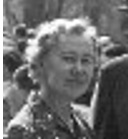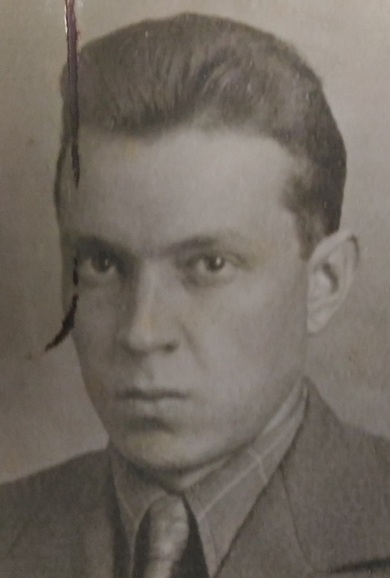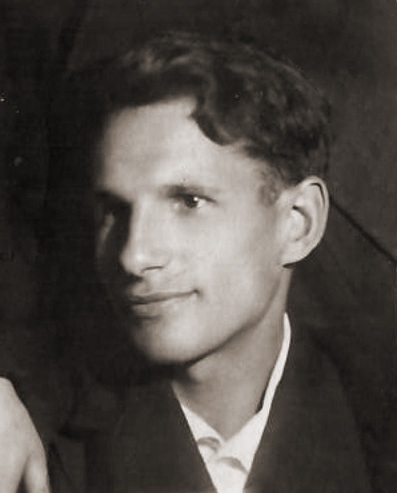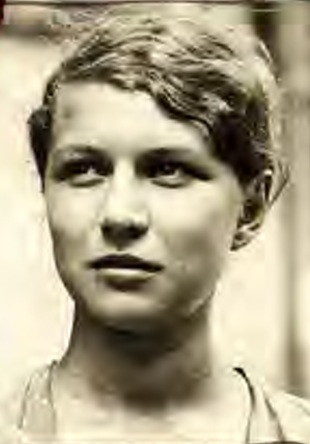Electrochemistry became a separate specialization for diploma students before the Department of Electrochemistry was established, starting from 1931 (A.N. Frumkin as a head of the laboratory of technical electrochemistry was responsible for this specialization). However, electrochemical diploma works existed earlier, due to Spitalsky’s research topics. The most early documented electrochemical diploma thesis we could find was completed in 1929 by L.L.Klyachko-Gurvich….. We start this list from 1930 because of ….
1930
Boris Nikolaevich Kabanov Aleksandr Ivanovich Shlygin
1931
Mikhail Abramovich Gerovich
Petr Dmitrievich Chugunov (1903-?)
1932
We know nothing about graduate 1932 names, but we have this photo. In the first raw, from left to right, N.N. Petin, Z.A. Iofa, and A.N. Frumkin are sitting. …..It was a period of enormous distortion of teaching and research by the reforms ….. “electrical engineers”

1933/34
In December 1933, 18 electrochemists defended their diploma theses, and their officiall graduation day is Jan 1, 1934 (selection from archive document, in Russian with a brief translation). This was the first release of the Department of Electrochemistry founded in spring 1933, and electrochemists made up about 20% of all Faculty graduates. Five people from the list are known for their contribution to further work of Frumkin school: Nina Alekseevna Balashova, Vladimir Ivanovich Veselovskyi, Vladimir Isaevich Medvedovskyi, Aleksandr Fedorovich Lunev, Afanasyi Il’ich Pankratov
Other names are listed below alphabetically, and the available scanty information is included.
Boris Grigorievich Abramov <Борис Григорьевич Абрамов> (1904-?) studied electrodeposition of ternary Cu-Zn-Cd alloys in the lab of technical electrochemistry in Karpov Inst, and continued to work in this lab for a year after graduation. Then he moved to the Moscow Institute of Chemical Engineering (МИХМ).
Ivan Dmitrievich Borsch <Иван Дмитриевич Борщ]> (1900-1992) was supervised by Z.A. Iofa and worked on carborundum electrode. Presumably, he never worked in research area later. His activities as communist party member are well seen in University records.
Maria Fedorovna Fedorova <Мария Федоровна Федорова>, “defense-related topic” is indicated in the list, which means some secret work…
Adol’f Antonovich Kaymin <Адольф Антонович Каймин> (1909-1989) worked on adsorption properties of Pd affected by saturation of solution with hydrogen and oxygen. He worked as an engineer in the field of power sources.
Anna Iosifovna Lipovetskaya <Анна Иосифовна Липовецкая> (1911-1993) studied hydrogen evolution on iron as dependent on electrolyte nature and composition. She worked with N.T. Kudryavtsev for some period.
Elena Ignat’evna Lopatskaya <Елена Игнатьевна Лопацкая> (1905-1985) completed the study “On the theory of carborundum electrode”. She changed her last name to Katukova later.
Antonina Ageevna Maksimtseva <Антонина Агеевна Максимцева> completed the study “Potentials of electrolytic alloys” (most probably this means corrosion potentials).
Grigory Ivanovich Melikhov <Григорий Иванович Мелихов> (1907?-1980?) studied the effect of sulfuric acid concentration on redox processes in the course of electrolysis of chromic acid.
V.[B?]I. Petrov <В.[Б?]И. Петров> who studied the temperature coefficient of tungsten electrode is most probably a student from Iofa’s list.

Valentina Fedorovna [Frolovna] Serge[y]eva <Валентина Федоровна [Фроловна] Сергеева> (1910-?) studied the electrocapillary curves in solutions of halogen-substituted aromatic compounds with Z.A. Iofa. During all her life, she worked at the Dept of physical chemistry in Kazach University (Alma-Ata). Her 1966 DSc thesis is devoted to salt effects on non-electrolyte solutions.
Valentina Aleksandrovna Strekopytova <Валентина Александровна Стрекопытова> (1911-?) completed the study “Potential drop on lead sulfide”. She started to work as an engineer. Her name is mentioned in the list of people repressed during Stalin period (arrested in 1934).
Semen Semenovich Zhitnikov <Semen Semenovich Zhitnikov> studied the capacitance and electric conductivity of amorphous substances in respect to their structure, this was probably some intersection with inorganic chemistry lab. He was transferred to Moscow Univ from the Institute of Chemical Technology in 1930.
Aleksandr Vassilievich Zimin <Александр Васильевич Зимин> (1907-?) started his work on recharging of oxidized carbon in alkaline solutions in frames of diploma thesis and continued in Karpov Institute (PhD 1938). These results were published in Acta Physicochim. URSS. 1937. V. 7. P. 451-458 (Zhurnal Fizicheskoi Khimii. 1937. V. 10. P. 761-765). Later he shifted to radiation chemistry of organic reagents, and also participated in organic synthesis research in Karpov Inst. He was active up to mid 1960s.

We should also mention that some students presented electrochemical diplloma theses in frames of specialization “inorganic catalysis”, and at least one of them was surely supervised by Z.A. Iofa:
Dmitryi Dmitrievich Senat[or]ov <Дмитрий Дмитриевич Сенат[ор]ов> worked on nicotine salts electrolysis with the flow-type diaphragm. This was the development of Spitalsky and Iofa works, in cooperation with tobacco industry.
1935/1936
During this period, defences of diploma theses where more frequent than once a year, mostly in 1936. <It looks like diploma defences by some parts of the graduating class, one-by-one, resulted from a limited space for experimental students’ work.> So there is no a single document, like in 1933/34. In available lists of students, specialization is not indicated, but the names of supervizers and reviewers are available. We list below all the students supervised by either members of the Dept of Electrochemistry, or by the staff of Karpov Inst (interfacial phenomena and technical electrochemistry labs), or reviewed by these electrochemical people.
Lidiya Vladimirovna Vanyukova, Evgenyi Mikhailovich Kuchinskyi, Aleksandr Andreevich Rakov, and Nikolay Andreevich Fedotov are known for their direct further contributions to the works of Frumkin school (should be assigned to the second group mentioned below). All others can be roughly divided into three topical groups.
One of these groups belongs more applied electrochemistry, partly inheriting Spitalsky period and intersecting with the topics of Spitalsky’s pupils working in other Depts:
Nikolay Andreevich Tokarev <Николай Андреевич Токарев> studied the formation of rings in the course of metal electrocrystallization under supervision of Z.A. Iofa. This study was inspired by the problem of galvanic baths operation.
Alexander Vladislavovich Bilevich <Александр Владиславович Билевич> (1908-1975) moved to Moscow Univ from the Moscow Chemical-Technological Institute and was a student of N.N. Petin. Bilevich’s diploma thesis on passivation and de-passivation of iron electrode was reviewed by Z.A. Iofa. Starting from 1937, he worked in the Moscow Aviation Institute, and later at the Dept of High Pressure Chemistry in Moscow University (he was the first staff member of this Dept created by L.F. Vereshchagin in 1954). He studied the properties of alloys, and developed high pressure equipment. His 1948 PhD thesis addressed Pb-Na alloys.

Ivan Stra[o]tonovich Artemov <Иван Стра(о)тонович Артемов> (1901-1949) also studied iron passivation and de-passivation under supervision of Z.A. Iofa (sodium sulphate solution is specified in his topic).
Nina ? Tikhomirova <Нина ? Тихомирова>, supervised by M.S. Golombik, studied electrochemical degreasing of metals. This work was reviewed by A.I. Shlygin.
Petr Stepanovich Filippovich <Петр Степанович Филиппович> was supervised by V.V. Monblanova and studied electrochemical reduction of cinnamic acid. He continued the studies of (electro)catalytic hydrogenation with Kobozev and Manblanova later. The work was reviewed by Z.A. Iofa.
Taisiya Aronovna Persits <Таисия Ароновна Персиц> was a student of Z.A. Iofa and V.I. Nesterova, and worked on the effect of gas atmosphere on tungsten electrode behavior.
The second group includes more basic topics typical for Frumkin school:
Anatolyi Petrovich Ksenofontov <Анатолий Петрович Ксенофонтов> (1908–?) first appeared in Karpov Inst as the technician in 1931, when he completed his ‘rabfak’ classes and entered Moscow University. Later he was supervised by M.A. Proskurnin. His diploma thesis (published in 1938) addressed the capacitance of mercury electrode in presence of surfactants.
Anna Ivanovna Frolova <Анна Ивановна Фролова> was a student of A.N. Frumkin, she measured the electrocapillary curves of benzene, naphtalene, and their hydrogenized derivatives.
Aleksey Ivanovich Platonov <Алексей Иванович Платонов> was supervised by A.N. Frumkin and A.I. Shlygin, and studied the pH dependence of adsorption on platinum. He served as technician of the Dept for some period in 1935. His potentiometric titration data for platinized platinum are mentioned in 1935/1936 article of Frumkin and Shlygin. Another student thesis mentioned in this article belongs to A. Chachaev, whose name we failed to find in any other documents.
Emilia Aronovna Razumovskaya <Эмилия Ароновна Разумовская> (1906-1994) worked with A.N. Frumkin and A.I. Shlygin, dealing with the effect of poisoning on the capacitance of platinum electrode. Her diploma data were published in 1939. She worked (for at least 30 years) with Mikhail M. Kusakov (1910-1971), who started with Derjagin and Rebinder, and applied colloid chemistry knowledge to oil-related problems. Starting from 1943, Kusakov’s lab of physics and physical chemistry of oil existed in the Institute of Petrochemical Synthesis. Razumovskaya’s PhD thesis (1951) addressed temperature-dependent viscosity of the lubricating oils.
Timofey Ivanovich Tolokonnikov <Тимофей Иванович Толоконников> had a similar topic, the effect of surfactants on the capacity of platinized platinum. His work was supervised by A.N. Frumkin and A.I. Shlygin.
Marina Panteleimonovna Morgunenko <Марина Пантелеймоновна Моргуненко> worked with A.N. Frumkin and Z.A. Iofa, and studied hydrogen evolution on mercury in concentrated sulpuric acid (Iofa’s favorite topic, which appears in his articles slightly later).
The third group is formed by the topics of D.V. Stepanov’s lab of technical electrochemistry. Students were supervised by the members of this lab and spent a year in Karpov institute:
Anna Ivanovna Barashenkova <Анна Ивановна Барашенкова> (1901-?) worked with T.G. Lyapuntsova and studied electrochemical blackening of copper and brass .
Mukhtar Garifulovich Rakhmankulov <Мухтар Гарифулович Рахманкулов> (1912–1942) was also Lyapuntsova’s student, who studied how oxygen adsorption on carbon affected their battery-related properties. After graduation he worked in Ufa Medical University, voluntarily went to the front when war started, and was killed there in 1942.

Felya Nau[i]movna Averbukh <Феля Нау[й]мовна Авербух> (1912-1980) worked under supervision of P.P. Belyaev, and studied brass deposition at high current densities.
Varvara Fedorovna Kokhova <Варвара Федоровна Кохова> and Nina Petrovna Rodionova <Нина Петровна Родионова> were supervised by P.S. Titov, both completed diploma theses titled “Electromotive force of galvanic cell”. One of these theses was reviewed by Z.A. Iofa, and another one by external person. Unfortunately the title does not allow to assume the content.
Fedor Ivanovich Buchenkov <Федор Иванович Бученков> was supervised by F.M. Marshak, and studied [hydrogen?] overvoltage on cobalt and nickel (diploma title cannot be interpreted unambiguously). He worked as a head of experimental lab at molding factory, dealing with, in particular, applied corrosion problems. He was arrested in the course of Stalin’s repressions, but survived, and returned to the same factory, at least in 1950s.
Polina Mikhailovna Koroleva <Полина Михайловна Королева> also worked with F.M. Marshak, studying the electrolyte of Leclanché element.
We should also mention two rather unusual 1936 diploma theses, surely electrochemical, but we cannot judge whether or not any interactions with Frumkin team existed in thes cases:
– Mariya Efimovna Mironova <Мария Ефимовна Миронова>, “Electrochemical fabrication of metallic lithium from non-aqueous electrolytes”. It was completed in the Institute of Inorganic and General Chemistry under supervision of Mikhail Antonovich Klochko (Bendetskyi) (1902-1986), who moved from Kiev and continued his research in frames of Plotnikov’s traditions. This thesis was reviewed by K.M. Gorbunova;
– Yakov Ivanovich Andrianov <Яков Иванович Андрианов> (1904-1956), “The study and analysis of anodic batteries produced by Czechslovak company PALA, and the laboratory reproduction of such batteries with their subsequent electrical characterization”. This spyware research was supervised by external applied chemist A.M. Pyarn (1892-1938) and reviewed by M.S. Golombik, inorganic chemist dealing with corrosion.
1937/38
Dmitrii Sergeevich Vargin, Yakov Mikhailovich Kolotyrkin, Gavriil Abramovich [Ioffe]-Deborin, Pavel Dmitrievich Lukovtsev, Ksenia Iosifovna Rozental’, Gavriil Platonovich Khomchenko, Boris Tsalevich Polinskyi
Vladimir Yakovlevich Aizenberg <Владимир Яковлевич Айзенберг> (1913-?) studied hydrogen evolution on lead electrode in concentrated sulphuric acid under supervision of Z.A. Iofa. He first graduated from chemical college in Odessa in 1927, and worked at the canning factories in the lower Volga region (in Hussenbach and Kamyshin). During his period in Moscow Univ (1933-1938) he continued to work at the factory for 5 months a year. He was accepted as PhD student in autumn 1938, but was forced to cancel, as the factory insisted on his return.
Pavel Stepanovich Petrov <Павел Степанович Петров> (1905-1972) is also mentioned in some records. Supposedly, he worked in Karpov Inst after graduation, but we still cannot identify his articles.
We only know presumably about 1938 graduation of Nadezhda Aleksandrovna Shumilova <Надежда Александровна Шумилова> (1916-1989), who worked with R.Kh. Burshtein. Her 1948 PhD thesis
1939
Nikolay Il’ich Martynov, Anna Ivanovna Fedorova (Pshennikova),

Nikolay Andreevich Budreiko <Николай Андреевич Будрейко> (1913-1976) entered Moscow Univ in 1934 as the 2nd year student, after several attempts to study in other Univ
Elena Mikhailovna Nanobashvili <Елена Михайловна Нанобашвили> studied electrokinetic phenomena, so we can assume that she was supervised by N.A. Bakh. Her 1945 PhD thesis on adsorption and electrokinetic properties of sols formed by local minerals/soils was defended in Tbilisi, Georgia. Then she appeared in the Institute of Physical Chemistry as N.A. Bach’s doctorant, and defended DSc thesis in 1952. The topic was radiation stability of oxide and oxohydroxide sols (radiation-induced coagulation). She continued in Georgia ….
Pavel Mikhailovich Nassonov <Павел Михайлович Нассонов> (1914-1990) was involved in defence-oriented research, so information about him is less available. Before and in the beginning of WWII he participated in development of batteries for low temperature environment, and later was doing something related to ‘atomic project’ in the Institute of Physical Chemistry.
Ambigous graduation year
Khanna Shmulevna [Anna Samuilovna] Titiyevskaya <Ханна Шмулевна Титиевская> studied electrocapillary phenomena in presence of cations. Her results of pre-WWII period were published with very long delay in 1957, and are also mentioned in 1937 additions to translation of M. Dole’s textbook written by B.N. Kabanov (so she graduated in the second half of 1930s, not later). Starting from 1939 she worked in colloid chemistry Dept of the Institute of Physical Chemistry, first with M.M. Kusakov (1940 publication), and then with B.V. Derjaguin (joint publications start from 1945 and continue up to at least 1960s; the review published much later is a version of lecture presented in 1961). She was retired in 1961.
In some records, G.N. Lagun, V.M. Sakharov (both can be found in Z.A. Iofa’s list), V.I. Likhachev and E.P. Mikheev are also mentioned as 1939 graduates.
The following diploma students are also listed in ‘before 1941’ list of Z.A. Iofa. We managed to find some information about very few of them, other names are simply listed at the end of this page.
Boris Zinovievich Ustinskyi <Борис Зиновьевич Устинский> (1913-1975) and F.I. Eiman <Ф.И. Эйман> are co-authors of 1939 Iofa’s article. Ustinskyi worked in applied electrometallurgy later (PhD 1949 in the Inst of Metallurgy (ИМЕТ), anodic dissolution of metal sulfides). Eiman was accepted as PhD student in 1938, but moved to the studies of heat capacity of metastable salts, most probably at the Dept of physical chemistry (PhD 1941). After WWII Eiman’s name can be found in the records of Khabarovsk Medical University, Chair of Chemistry.
A.S. Prokofieva co-authored 1939 article of Kabanov and Iofa.
K.P. Mikulin <К.П. Микулин> co-authored Iofa’s article published in 1944, but it was delayed publication (experimental work was completed before WWII, as mentioned in the text). As the combination of initials is not so usual, we can assume that this graduate was Konstantin Poment’evich <Константин Поментьевич> Mikulin, born in 1915, killed at the front during WWII.
V.M. Stepanova co-authored Iofa’s 1945 article, but she surely was a student before WWII: she is mentioned as a student in Dept records of 1939, in respect to the measurements of hydrogen overpotential at various temperatures.
Dmitryi Konstantinovich Zhestkov <Дмитрий Константинович Жестков> was involved to applied analysis of oil and bitumen, which finally became a subject of his PhD thesis (1963). His publications on chromatographic analysis can be found up to 1975, affiliated with Topchiev Institute of Petrochemical Synthesis.
Zlata Vassilievna Zvonkova <Злата Васильевна Звонкова> worked in Karpov Institute, dealing with crystal chemistry of polymers, organic substances, and coordination compounds with organic ligands. She defended DSc thesis in 1970, and remained active with publications up to 1980.
Yu.S. Press <Ю.С. Пресс> defended PhD thesis on nickel electroсрochemical refining in the Moscow Institute of Non-Ferrous Metals and Gold (МИЦМиЗ) in 1949. We failed to clarify later activities, excluding editor role in the conference proceedings on extraction and sorption in technologies of non-ferrous metals (1969).
Minna Mironovna Kristal’ <Минна Мироновна Кристаль> (1918-1995) was graduated aftere WWII, but she started her studies of the temperature dependence of electrocapillary curves before war, according to Z.A. Iofa’s records. The same topic is mentioned for A.E. Chebotarev in 1939. Minna Kristal’ was later known for her applied corrosion research, specifically for steel and composite materials corrosion in chemical industry. She was affiliated with the Institute of Chemical Engineering (ЦНИИХиммаш) for many years. Her first book “Corrosion of chemical apparatus” (1958) was co-authored with Galina Lazarevna Schvarts (1915-1999). Later she completed her thesis (1963) and published/edited various review texts and collections in the same field.
Revekka Moiseevna Nepomnyashchaya <Ревекка Моисеевна Непомнящая> (1909-1978) is mentioned in Z.A. Iofa’s records as a student who studied reduction reactions at the diffusion side of palladium cathode in 1935. This was most probably a joint work with V.V. Monblanova.
Irina Viktorovna Skanavi (Buteskul) <Ирина Викторовна Сканави (Бутескул)> (1915-1993) teached chemistry in various technical universities in Moscow, in particular, in the Institute of Radio Engineering, Electronics, and Automation (МИРЭА). She married mathematician Mark I. Skanavi, an author of a famous taskbook.

S.I. Kolotilin <С.И. Колотилин> worked presumably in applied galvanics (a person with the same name authored a number of Russian patents in this field). B.G. Varshaver <Б.Г. Варшавер> is presumably Bella Grigor’evna Varshaver who defended PhD thesis (1952) concerning the effect of surfactants on photo emulsions.
Several names of students from and beyond ‘before 1941’ list can be found in pre-WWII internal reports or in footnotes in the articles: P.V. Agarkov <П.В. Агарков> (served as technician in 1938, mentioned as diploma student in 1939 article related to surfactants effects on hydrogen evolution on mercury); Chernenko <Черненко>, no initials (mentioned in 1935, working on the effect of platinum surface pretreatment); Galkin <Галкин>, no initials (mentioned in 1937, in respect to the study of hydrogen overvoltage in concentrated acids); Kalinin <Калинин>, no initials (mentioned in 1939, studying hydrogen overvoltage on lead); Kochetkova <Кочеткова>, no initials (mentioned in 1935, working on electrocapillary behavior of halogen-substituted organic substances in non-aqueous solutions); Makarov, no initials (mentioned in 1935, in respect to the study of poisonong of the electrodes from W and Sb oxides);
Other names form ‘before 1941’ list are N.M. Balo[a]ban <Н.М. Бало[а]бан>; Yu.S. Chikulieva? <Ю.С. Чикулиева?> (the last name is quite illegible); A.I. Chistova <А.И. Чистова>; A.I.? Echeistova <А.И.? Ечеистова>(the second initial is illegible); D.D. Frolov <Д.Д. Фролов>; A.N. Ivanov <А.Н. Ивано?в>; Iv[an] Pavl[ovich] Mikhailov <Ив[aн] Павл[ович] Михайлов>; S.S. Mok[h]orov <С.С. Мок[х]оров>; V.S. Palkin <В.С. Палкин>;